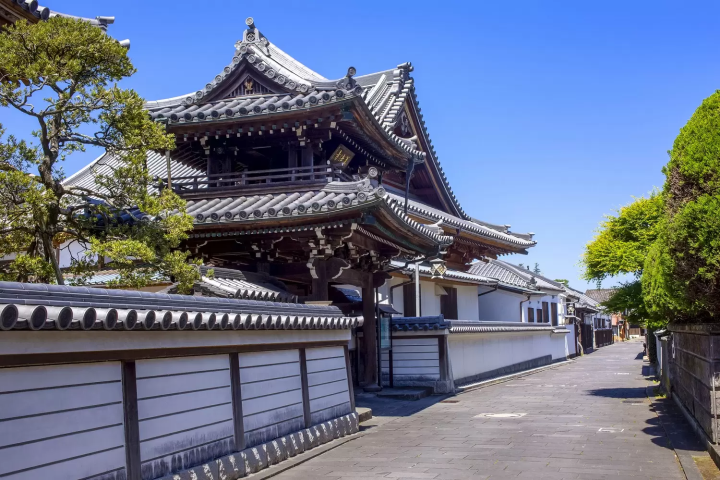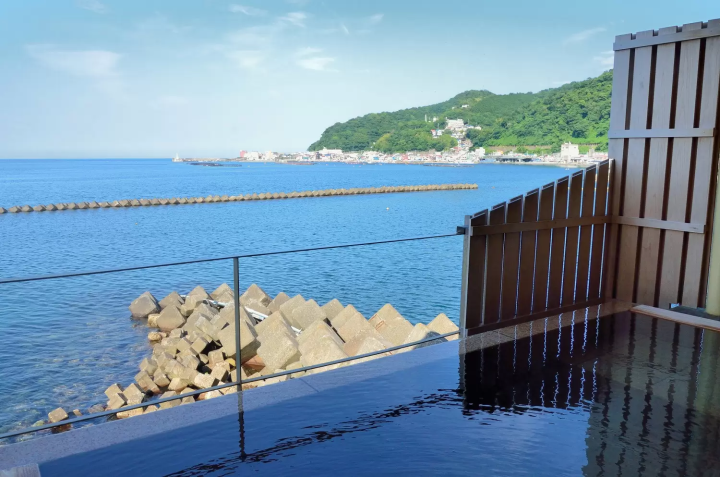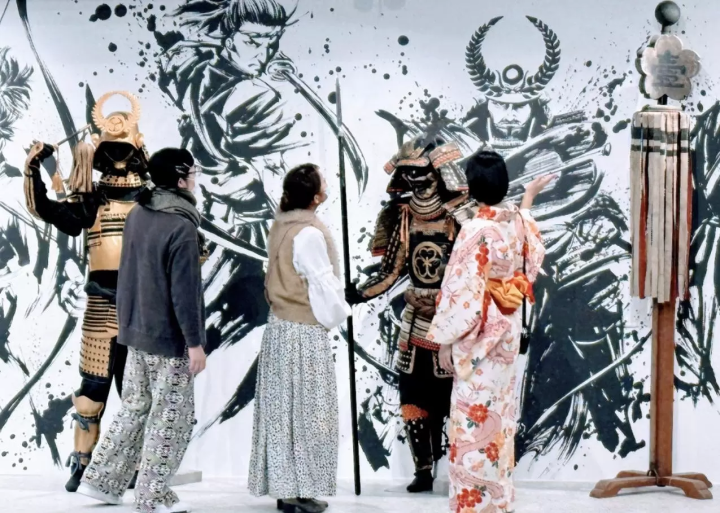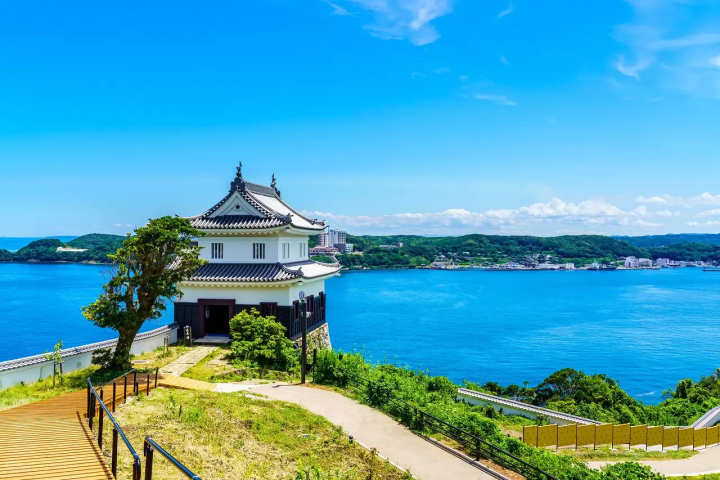Shogun: 12 Places Related to William Adams, the Blue-Eyed Samurai

The plot of the popular TV series and bestselling novel "Shogun" was inspired by the true story of William Adams, a British navigator who served shogun Tokugawa Ieyasu. We introduce 12 places in Japan related to William Adams, from Osaka Castle to Nihonbashi in Tokyo and Hirado Island in Nagasaki.
William Adams (1564 - 1620) was an English navigator who arrived in Japan in 1600 on a Dutch commercial ship. He ended up settling in Japan and serving shogun Tokugawa Ieyasu (1543-1616) as a high-ranking samurai, assisting the Tokugawa government in developing ships and a fleet.
Adams' life inspired James Clavell to write his bestselling novel "Shogun," in which the main character is John Blackthorne. "Shogun" was developed into a movie in 1980 and a TV series that aired recently, and also inspired the Nioh video game franchise.
In this article, we introduce 12 places across Japan that are related to William Adams, a historical figure whose legacy had a significant impact on Japan. Visit them to experience the world of Shōgun!
Shogun: Places in Japan Related to William Adams
1. Usuki, Oita
2. Osaka Castle
3. Azuchi Castle
4. Hikone Castle
5. The Ruins of Fushimi Castle in Kyoto
6. The Battle of Sekigahara Museum
7. Yokosuka
8. Ajiro Onsen in Atami
9. The Nihonbashi District in Tokyo
10. The Samurai Ninja Museum with Experience
11. Dejima
12. Hirado Island
1. Usuki City in Oita

Photo by Pixta
After a long, ruthless battle at sea and the loss of four ships, the Liefde, William Adams's last boat, arrived at the shores of present-day Usuki City in Kyushu in 1600 with just a handful of men remaining. His arrival marked the first landing of a British man on Japanese soil.
Due to Japan's trade relations with the Portuguese, many of whom resided in Kyushu, Adams's presence as a British man sailing with a Dutch fleet was an unwelcome combination, especially amidst the ongoing Anglo-Spanish war.

Photo by Pixta
Met with hostility when the Portuguese Jesuit missionary priests arrived a few days later as interpreters, Adams and his men were accused of being pirates. The priests insisted on their execution but the men caught the attention of lord Tokugawa Ieyasu, who demanded that they be brought to Osaka Castle for questioning.
Japan had been in a state of turmoil and civil war, which ended when Tokugawa became shogun after 1600, marking the beginning of the Edo period (1603-1868).
Usuki is now a quiet portside town brimming with local charm and a well-preserved samurai residence district, the Nioza Historical Road. Usuki Castle Park offers beautiful views of the city and the bay.

In Usuki, you can step into the shoes of the British navigator and explore the streets of the small town while enjoying spots such as Sala de Usuki, which displays a miniature model of the Liefde and other artifacts related to the first Europeans who reched Japan, to Kuroshima Island where they landed.
Fans can walk the historical streets with a sense of wonder at the stark difference of historical Japan to their homeland. You can step into his shoes and wonder what it would’ve been like to suddenly arrive in a world so far removed from your own!
↑ Return to the top of article.
2. Osaka Castle

Photo by Pixta
Transported to Osaka Castle after being discovered in Kyushu, the soon-to-be shogun, Tokugawa Ieyasu, was extremely interested in Adams and his men. Tokugawa became impressed with the Dutchmen, Adams's knowledge of navigation and boats, his stories, and his religious Protestant views.
Seizing Osaka Castle from Hideyoshi’s successor, Hideyori, just months before Adams's arrival, Tokugawa was in the midst of a raging war with Toyotomi’s loyalists, who strongly believed that the young Hideyori was the rightful leader of the country.
With William Adams' crew, knowledge, and skills, Tokugawa knew the British man would be a valuable resource for him. He recruited Adams as one of his advisors.
The center of much of the intrigue in Shogun, visitors to Osaka Castle can enjoy a walk around the castle moat, plotting in the footsteps of the cunning general Toranaga.
While the interior may no longer reflect the halls of tradition and political power play, Osaka Castle can teach a lot of Shogun fans more about the great figures whose legacies shape the story moving forward!
↑ Return to the top of article.
3. Azuchi Castle

Photo by Pixta
As William Adams battled the seas on his way to Japan, turmoil gripped the land of the rising sun. With the mission of reunifying Japan, which was fragmented into prefectures ruled by individual daimyo, lord Oda Nobunaga (1534-1582) had initiated his conquest.
By successfully securing Kyoto as the capital and garnering numerous supporters, Nobunaga oversaw the creation and construction of Azuchi Castle. Perched atop Mt. Azuchi, the castle offered a commanding view of Lake Biwa, Japan's largest lake, serving as an ideal vantage point for samurai to oversee Kyoto and its environs while also boasting a robust defense system.
Azuchi Castle was not only a stronghold but also a residence for the samurai. Opulent both inside and out, it was adorned with lavish decorations and artwork. Exterior walls featured painted murals depicting dragons and tigers, contributing to its uniqueness. The castle sported innovative designs, such as high-rise walls, blue-tiled roofs, a golden tower, and a distinctive octagonal-shaped red floor at its core.
The castle met its end in 1582 when lord Akechi Mitsuhide (1528-1582), one of Nobunaga's trusted aides, turned against him, assassinating Nobunaga at the Honnoji Temple. Today, only the castle ruins remain. Adjacent to the site, visitors can explore the Nobunaga no Yakata Museum, where a replica of the castle is on display, offering detailed insights into its history and features.
Azuchi Castle takes Shogun fans on a trip into the misty past of the series back to the origins of Toda Mariko, a character modelled on Hosokawa Gracia, the daughter of Akechi Mitsuhide, and her desire for vengeance.
Here at the castle visitors can walk in the footsteps of a young Mariko as she grew up rarely far removed from the plotting and cunning of the men who vied for rulership of Japan.
↑ Return to the top of article.
4. Hikone Castle

Photo by Pixta
The magnificent Hikone Castle, located in Shiga Prefecture, stands as one of Japan's most captivating castles. Boasting an impressive defense system, it is classified as a National Treasure and is one of the 12 original castles that still exist in Japan today.
In 1601, Ii Naomasa, one of the generals serving Tokugawa, survived the fierce Battle of Sekigahara (October 1600) and ascended to the rank of daimyo (feudal lord). Shortly after, he embarked on the construction of Hikone Castle.
Renowned as a warlord distinguished in tactics, Naomasa initially oversaw Sawayama Castle, located a short distance from the present-day Hikone Castle. Not content with Sawayama's defenses, he orchestrated the design and construction of Hikone Castle on the shores of Lake Biwa.
Tragically, complications arising from battles claimed Naomasa's life in 1602 before he could witness the completion of his vision. His clan persevered, and in 1622, the grand edifice stood as a testament to his ambitions.
Over time, the waters of Lake Biwa have receded due to land reclamation efforts. Visitors can still relish the castle's splendid grounds and gardens while delving into its remarkable defense strategies. They may also have the delight of meeting Hikonyan, the castle's resident samurai cat mascot inspired by Ii Naomasa.
Hotels near Hikone Castle
Read also
↑ Return to the top of article.
5. The Ruins of Fushimi Castle in Kyoto

Photo by Pixta
Constructed to serve as a grand retreat for lord Toyotomi Hideyoshi (1537-1598) in his later years, Fushimi Castle failed to provide the peace its creator desired. The edifice met its initial demise just two years after its completion in 1594 when it succumbed to an earthquake.
Undeterred by this setback, Hideyoshi commanded the castle's reconstruction, later entrusting its defense to Torii Mototada under the orders of Tokugawa Ieyasu following the samurai's passing.
Hideyoshi's death in 1598 set the stage for fresh turmoil as his former allies split into opposing factions, giving rise to two distinct armies. The Western army rallied behind the ambitions of Toyotomi Hideyori, the deceased leader's young son, under the guidance and protection of lord Ishida Mitsunari. In stark contrast, dissatisfied for various reasons, Tokugawa Ieyasu marshaled the Eastern Army in opposition.
In the ensuing years, Torii Mototada, one of Ieyasu's trusted lieutenants, vigilantly safeguarded the castle for a span of two years. However, chaos erupted in 1600 when Ishida Mitsunari launched a ferocious assault on the castle with his forces, subjecting the stronghold and its inhabitants to a relentless siege lasting 11 days. This fierce onslaught bought crucial time for Tokugawa Ieyasu to assemble his forces, ultimately tipping the scales in his favor during the pivotal Battle of Sekigahara.
Despite hailing from a lineage devoted to the Tokugawa clan, Torii Mototada valiantly defended the castle against overwhelming odds, contending with 40,000 troops. The warlord was eventually overcome as Ishida Mitsunari's forces breached the defenses, leading to Torii Mototada's defeat and execution. His 360 troops chose to commit seppuku rather than surrender, and the castle met a fiery end. Legend holds that some of its wooden floors were repurposed in temples throughout Japan where visitors can observe supposed bloodstains on the temple's wooden ceilings.
To honor Torii Mototada's valor, a replica of Fushimi Castle now stands at the site, serving as a museum for visitors seeking to delve into this poignant chapter of Japanese history.
↑ Return to the top of article.
6. The Battle of Sekigahara Museum

Photo by Pixta
Arguably the most pivotal battle in securing Tokugawa Ieyasu's position as shogun was the Battle of Sekigahara, which took place in October 1600. Amidst political tensions, the Western army representing the Toyotomi clan clashed with Tokugawa's Eastern army, leading to chaos that culminated after Tokugawa's seizure of Osaka Castle and the demise of Toyotomi Hideyori.
Seizing the opportunity, Ieyasu, opposed to the future leadership of Hideyori Toyotomi and his Western army, capitalized on the power vacuum post-Hideyori's death. With the Shogunate position now up for grabs, Tokugawa advanced toward Sekigahara for what would become Japan's largest feudal battle.
In the thick fog of October 21, 1600, Tokugawa Ieyasu and his adversary Ishida Mitsunari, who had previously laid siege to Osaka Castle and defeated one of Tokugawa's key allies, converged at the battleground. In a moment of accidental encounter when a Tokugawa guard bumped into the opposition force, chaos ensued, prompting both sides to regroup.
As the fog lifted, unveiling the positions of each army, the battle commenced with ruthless commands echoing through the air. Amidst the muddy grounds, high-ranking leaders of both armies' divisions navigated the challenging conditions and led their troops into combat.
Today, the Gifu Sekigahara Battlefield Memorial Museum stands on the historic battleground, offering a detailed account of the conflict, the key figures involved, and the intricate history of the period. For enthusiasts of this era or those seeking to delve deeper into Japanese history, a visit to this site comes highly recommended.
Gifu Sekigahara Battlefield Memorial Museum
Location: Gifu, Fuwa District, Sekiahara 894-55 Map
Webste: https://sekigahara.pref.gifu.lg.jp/en/
↑ Return to the top of article.
7. Yokosuka

The Kurihama Port in Yokosuka. Photo by Pixta
Hoping to reunite with his wife and children, Adams yearned for his homeland, but his significance to the reigning shogun rendered his departure an impossibility.
Tokugawa Ieyasu extended a host of privileges to Adams, including land, a personal estate, and servants. Additionally, he bestowed upon Adams the esteemed title of hatamoto, altering his name to Miura Anjin. This transformation symbolized a definitive break from William Adams's past life, firmly integrating him as a loyal retainer to the Tokugawa clan.

Photo by Pixta
Adams's fiefdom was established in Hemi, Yokosuka, a coastal city renowned today for its naval base. The area abounds with remnants of this distinguished samurai and his impact on the locale, evident in landmarks such as Anjinzuka Station and Anjindai Park, both named in his honor.
Additionally, a memorial grave dedicated to him can be found at Tsukayama Park, serving as a testament to his legacy in the region.
↑ Return to the top of article.
8. Ajiro Onsen in Atami

Photo by Pixta
After consolidating his rule as shogun, lord Tokugawa orchestrated the move of the capital from Kyoto to Edo (present-day Tokyo). As a consequence, William Adams secured residences in both Yokosuka and Nihonbashi.
Furthermore, Adams was tasked with the design and construction of galleons, large sailing ships, in Ito, Shizuoka, located near Tokyo. There, he collaborated with Mukai Shogen, the commander-in-chief of the navy of Uraga, to fabricate an 80-tonne ship at Ito's port.
Impressed by the capabilities demonstrated in shipbuilding, lord Tokugawa, merely a year later, directed the team to construct a 120-tonne vessel, later named the San Buena Ventura. This ship was slightly less than half the size of the Liefde, showcasing the advancements made under Adams' guidance.

Photo by Pixta
Ito stands as a popular tourist destination in the Izu Peninsula drawing visitors to its harbor and the neighboring town of Atami for relaxing hot spring retreats and the chance to explore its remarkable historical architecture. Ajiro Onsen is thought to be the place where Adams learned to love hot spring baths.
Scattered throughout the town are sites and structures linked to William Adams, who was referred to as Anjin by that time. Notable locations include the magnificent Tokaikan, a museum situated within a former onsen inn, and the Anjin Memorial Park, which showcases statues, floor murals honoring the navigator and his vessels, and a replica of the San Buena Ventura at the Ito City Hall.
To honor the memory of William Adams and Japan's inaugural Western-style ship, the annual Miura Anjin Festival is held. This vibrant event features fireworks illuminating the night sky above the beach and the launching of lanterns into the sea from the Matsukawa River, marking a celebration of their legacy.
The sophisticated hotel Hoshino Resorts KAI Anjin was themed and designed based on the story of William Adams. Shogun fans would love spending a day at this accommodation!
Read also
↑ Return to the top of article.
9. The Nihonbashi District in Tokyo

Photo by Pixta
In Tokyo's Nihonbashi district, there lies Anjin-dori street, bearing the name of the British navigator. This was the very street where Adams lived with his Japanese family when he was woking close to the shogun in Edo.
Along this historic street, visitors can discover a monument commemorating William Adams. There is also a ship statue situated on Marunouchi Street, serving as enduring tributes to his presence and contributions in the area.
10. The Samurai Ninja Museum with Experience

Photo by PR Times
Immerse yourself in the world of Japan's agile samurai and mysterious ninjas at the Samurai Ninja Museum! This unique venue provides a comprehensive experience for guests, blending historical insights on both samurai and ninjas with interactive activities.
Visitors have the opportunity to encounter exquisite and intricate armor, swords, and weaponry while delving into the philosophy of bushido, the Japanese samurai code of ethics, and the secretive art of ninjutsu practiced by ninjas. It's a journey that offers a hands-on exploration of these fascinating aspects of Japanese history and culture.

Photo by PR Times
Visitors to the museum have the exciting opportunity to don heavy samurai armor or light ninja attire and engage in hands-on activities such as practicing with weapons, from throwing shuriken to mastering the art of cutting bamboo with a katana sword.
SAMURAI NINJA MUSEUM TOKYO With Experience
Location: Tokyo, Taito, Nishi Asakusa 1-8-13
Hours: 10:00 - 18:00
Website: https://mai-ko.com/samurai/tokyo.html
Located a short distance away is the Musashi Ichizoku Dojo, belonging to a 400-year-old ninja clan renowned for their historic actions, including aiding in the rescue of Tokugawa Ieyasu in 1582 as he fled from Osaka following the betrayal and assassination of Nobunaga.
The ninja clan safeguarded the samurai until they reached Ise, a village notorious for its ninjas in Japan. Subsequently, they became loyal allies to the Tokugawa clan, serving as the sole ninja clan to act as agents for the Edo Shogunate.
The Musashi Ninja Clan Shinobi-Samurai Honjin Dojo is now accessible to the public, offering a diverse range of workshops that encompass samurai and ninja experiences, as well as educational seminars and training sessions. Individuals also have the opportunity to become members and engage in these immersive activities.
↑ Return to the top of article.
11. Hirado Island

Photo by Pixta
Situated in Nagasaki, the charming port town of Hirado stood as Japan's inaugural international trading port, boasting a rich history of trade with Asia spanning centuries. During the Sengoku and Edo periods, Hirado transitioned into a hub welcoming Western influences, showcasing multiple world heritage sites like churches and a Dutch trading center, now transformed into a museum housing artifacts from the dynamic Sengoku and Edo eras.
Renowned as the final resting place of William Adams, Hirado features an exquisite fusion of Western and Japanese architectural marvels, encompassing churches, castles, and Japanese Buddhist temples and pathways.
Adams's legacy permeates the town, echoed through his tomb, statues, and the monument commemorating the British and Japanese trading post on Saiwai Bridge, a tribute to the demolished British trading hub.
Despite years of correspondence with England, Adams was dismayed to discover that his attempts to foster England - Japan trade relations and reestablish connections with his family were thwarted by Dutch interference. His revelation of the British presence in Indonesia prompted a renewed initiative to invite British trade to Japan. This effort bore fruit as evidenced by the arrival of John Sarris, Chief Merchant and Captain of the Ship Clove, signifying a successful milestone in bridging trade relations between England and Japan.

Photo by Pixta
Collaborating with John Sarris, Adams obtained permission from Tokugawa Ieyasu to establish an English trading post in Hirado and also secure approval for Adams to journey to England.
During his time with Sarris and the crew, Adams realized his deep immersion in Japanese culture and etiquette after spending most of his adult life in Japan. Feeling a sense of estrangement from his English compatriots, Adams made the decision to forego returning to England and opted to remain in Japan, continuing to travel to various countries from Hirado.
However, the prospects for trade between London and Japan dimmed following Sarris's visit, with only three ships engaged in trading activities and eventually, the British trading post met its demise.
Four years subsequent to Tokugawa Ieyasu's passing, amidst significant changes in his life, William Adams breathed his last at the age of 55 in Hirado in 1621. His final resting place lies adjacent to the iconic Saint Francis Xavier Church, marking the culmination of his remarkable journey in Japan.
↑ Return to the top of article.
12. Dejima

Photo by Pixta
Located in Nagasaki, the artificial island of Dejima was established to confine and monitor Christianity while permitting trade into Japan. While initially accepted by Nobunaga but disapproved of by Hideyoshi, Christian adherents in Japan faced severe persecution under the Toyotomi clan's regime. Followers of the faith were uprooted from places like Osaka and Kyoto and relocated to Nagasaki.
The era of Hideyoshi saw a series of executions that instilled terror among Japanese Christians, prompting many to seek refuge in hidden enclaves across Nagasaki, now recognized as the Hidden Christian Sites in the Nagasaki Region.
When Tokugawa ascended as shogun, he advocated for vibrant international trade flowing into ports like Hirado but aimed to curb the widespread influence of Christianity in Japan. Consequently, the shogunate orchestrated the construction of an artificial island off the Nagasaki port, designed to accommodate a communal settlement for Portuguese traders in the city. Dejima started functioning in 1636, 20 years after Tokugawa's death.
Throughout the Edo period spanning about two centuries, Japan enforced isolationist policies, restricting trade exclusively to sanctioned ports. Dejima experienced the arrival of approximately 700 Dutch vessels, ferrying a diverse array of commodities ranging from books to ceramics, copper, and textiles.
Dejima ceased to operate six years after the shogunate signed the United States of America - Japan Treaty of Amity and Commerce in 1858. Today, travelers exploring Nagasaki can immerse themselves in the preserved residences and reconstructed warehouses at Dejimamachi, a compact district serving as a rich repository of artifacts, history, architecture, and design within Nagasaki City.
Read also
↑ Return to the top of article.
Enjoy Exploring Historical Sites Related to Shogun
We hope that the historical sites mentioned above will inspire you to explore some of them. They offer precious insights abut the beginning of commercial and diplomatic relations between Japan and European countries, a history that is no less fascinating than the exciting plot of "Shogun."
Read also
Main image by Pixta
Assistant editor at MATCHA since 2023, Kate is a photographer who enjoys traveling Japan's hidden gems and adventuring off the beaten path. Living in Japan since 2018, she has traveled across different areas of Japan. From indulging in Aomori’s apple pies and fiery festivals to exploring the quaint charm of Nagasaki’s cat-filled streets she is always searching for new areas full of atmospheric beauty, festivals, and seasonal events to capture on camera.
















































![[Just a short distance from Nagoya] Popular Taiwanese YouTuber Alan tours Aichi, Tokoname!](https://resources.matcha-jp.com/resize/720x2000/2026/01/08-255181.webp)

